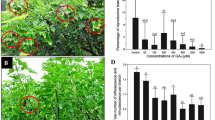Summary
The effect of gibberellins A1 through A9 on stem elongation and flower formation in five plants was tested. The plants wereMyosotis alpestris and a biennial strain ofCentaurium minus (cold-requiring plants),Silene armeria andCrepis parviflora (long-day plants), andBryophyllum crenatum (a long-short-day plant). The two former plants were maintained on non-inductive temperatures and long days, the three latter on short days, InMyosotis, flower formation was only obtained with GA7 and GA1, the latter being relatively less active. InCentaurium GA3 was the most effective, followed by GA1, GA4 and GA7 and perhaps GA5 and GA9. InSilene, flower formations was induced only by GA7. InCrepis, the most effective gibberellins were GA4 and GA7, inBryophyllum, GA3, GA4 and GA7. Thus, the different gibberellins exhibited considerable differences in their activity with respect to flower induction, and different plants exhibited in this respect certain specific differences in their sensitivity to the various gibberellins. Except inCrepis, flower initiation as a result of gibberellin treatment was always preceded by substantial stem or internode elongation; however, the correlation between the effect of the different gibberellins on stem elongation and flower induction was not in all cases complete. No correlation of the flower-inducing and elongation-promoting activity with the chemical structure of the different gibberellins could be recognized.
Similar content being viewed by others
Literature
Brian, P. W., andH. G. Hemming: Promotion of cucumber hypocotyl growth by two new gibberellins. Nature (Lond.)189, 74 (1961).
——, andD. Lowe: Relative activity of the gibberellins. Nature (Lond.)193, 946–948 (1962).
Bünsow, R., u.R. Harder: Blütenbildung vonBryophyllum durch Gibberellin. Naturwissenschaften43, 479–480 (1956).
Bukovac, M. J., andS. H. Wittwer: Comparative biological effectiveness of the gibberellins. Nature (Lond.)181, 1484 (1958).
——: Biological evaluation of gibberellins A1, A2, A3 and A4 and some of their derivatives. In: Plant Growth Regulation (Fourth Internat. Conf. on Plant Growth Regulation, Yonkers, N.Y., U.S.A., August 1959), pp. 505–520. Ames, Iowa: State Univ. Press 1961.
Carr, D. J., A. J. McComb andL. D. Osborne: Replacement of the requirement for vernalization inCentaurium minus Moench by gibberellic acid. Naturwissenschaften44, 428–429 (1957).
Chajlakhyan, M. Kh., andV. N. Lozhnikova: Gibberellin-like substances in higher plants and their effect on growth and flowering. [In Russ.] Fiziol. Rast.7, 521–530 (1960).
Cross, B. E., J. F. Grove, P. McCloskey, J. MacMillan, J. Moffatt andT. P. C. Mulholland: The structure of the fungal gibberellins. Adv. in Chem.28, 3–17 (1961).
Halevy, A. M., andH. M. Cathey: Effects of structure and concentration of gibberellins on the growth of cucumber seedlings. Bot. Gaz.122, 63–67 (1961).
Harada, H., andJ. P. Nitsch: Changes in endogenous growth substances during flower development. Plant Physiol.34, 409–415 (1959).
Hashimoto, Y., andT. Yamaki: On the physiological effects of gibberellins A1, A2, A3, and A4. Bot. Mag. (Tokyo)72, 178 (1959).
——: Comparative effectiveness of gibberellins A1, A2, A3 and A4, with special reference to that of A4. Bot. Mag. (Tokyo)173, 64–68 (1960).
Lang, A.: The effect of gibberellin upon flower formation. Proc. nat. Acad. Sci. (Wash.)43, 709–717 (1957).
—: Gibberellin-like substances in photoinduced and vegetativeHyoscyamus plants. Planta (Berl.)54, 498–504 (1960).
—: Entwicklungsphysiologie. Fortschr. Bot.23, 312–345 (1961).
— andE. Reinhard: Gibberellins and flower formation. Adv. in Chem.28, 71–79 (1961).
—,J. A. Sandoval andA. Bedri: Induction of bolting and flowering inHyoscyamus andSamolus by a gibberellin-like material from a seed plant. Proc. nat. Acad. Sci. (Wash.)43, 960–964 (1957).
Lazer, L., W. E. Baumgartner andR. V. Dahlstrom: Determination of endogenous gibberellins in green malt by isotopic, derivative dilution procedures. Agric. and Food Chem.9, No 1, 24–26 (1961).
Liverman, J. L., andA. Lang: Induction of flowering in long-day plants by applied indoleacetic acid. Plant Physiol.31, 147–150 (1956).
Lockhart, J. A., andP. H. Deal: Prevention of red light inhibition of stem growth in theCucurbitaceae by gibberellin A4. Naturwissenschaften47, 141–142 (1960).
MacMillan, J., J. C. Seaton andP. J. Suter: Isolation and structures of gibberellins from higher plants. Adv. in Chem.28, 18–25 (1961).
Michniewicz, M., andA. Lang: Effect of gibberellins A1 through A9 on flower formation inMyosotis alpestris L. Naturwissenschaften49, 211–212 (1962).
Penner, J.: Über den Einfluß von Gibberellin auf die photoperiodisch bedingten Blühvorgänge beiBryophyllum Planta (Berl.)55, 542–572 (1960).
Reinhard, E., andA. Lang: Natural gibberellins inHyoscyamus niger in relation to development especially to flower formation. (Abstr.) Plant Physiol.36, Suppl., xii (1961).
West, C. A., andT. Reilly: Properties of gibberellins from flowering plants. Adv. in Chem.28, 37–41 (1961).
Wittwer, S. H., andM. J. Bukovac: Quantitative and qualitative differences in plant response to the gibberellins. Amer. J. Bot.49 (1962, in press).
Zeevaart, J. A. D., andA. Lang: The relationship between gibberellin and floral stimulus inBryophyllum daigremontianum. Planta (Berl.)58, 531–542 (1962).
Author information
Authors and Affiliations
Additional information
With 2 Figures in the Text
Work in part supported by the National Science Foundation, grants G-16408 and G-17483.
Rights and permissions
About this article
Cite this article
Michniewicz, M., Lang, A. Effect of nine different gibberellins on stem elongation and flower formation in cold-requiring and photoperiodic plants grown under non-inductive conditions. Planta 58, 549–563 (1962). https://doi.org/10.1007/BF01928367
Received:
Issue Date:
DOI: https://doi.org/10.1007/BF01928367




